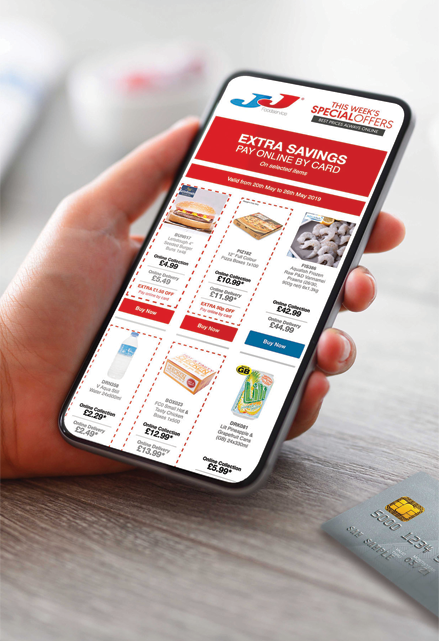Helena Drakakis looks at six key changes wholesalers can make to their operations that will improve both the customer experience and profits
Innovation in the convenience channel is growing at breakneck speed. Sainsbury’s opened its first till-free grocery in London in April, while Aldi’s small-format store, Aldi Local, also made its debut in London this year with more planned. Both pose a threat to the independents and symbols served by wholesale. For the retail customer, a quick, simple, reliable and increasingly personalised service is driving how and where they shop. Yet, wholesale lags behind when it comes to tailoring its customer experience.
Maximise warehouse potential
Several wholesalers are starting to improve the customer journey by offering a delivery option plus a click and collect service, alongside the traditional cash and carry service. One such company is AG Parfett & Sons, which moved to a hybrid 24-hour operation in its Sheffield depot following a restructure of the business three years ago. The wholesaler now offers the enhanced service to members of its Go Local fascia and has been able to target new areas outside of its catchment area, such as Hull and Grimsby.
“By moving to a 24-hour operation, we are giving our retailers more flexibility while still delivering great value,” says Parfetts’ retail director, Guy Swindell. While a click and collect service operates from every Parfetts depot, deliveries run from the Sheffield and Somercotes sites.
The Sheffield site operates up to 8pm as a cash and carry, and transforms into a picking and distribution centre throughout the night, with orders taken up to midnight for next-day delivery. Meanwhile, at Somercotes, which closes at 6.30pm, picking for overnight delivery is carried out during the day in quiet periods.
“Sheffield is now our best-performing site in terms of year-on-year growth. The move to 24 hours has seen the established operation outperform the market with 10% growth in the past 12 months. Online has grown to 42% of the depot’s total sales and is expected to hit 50% this year,” adds Swindell.
Nurture your clients
Managing data and gaining insight from its collection can assist in nurturing existing customers, attracting new ones and bringing back lapsed custom. “If customers are truly the most important part of your business, then customer data should also be key. Good customer data management ensures you treat your customers’ data fairly and legally, it helps you enhance customer experience via personalisation, and, ultimately, can help make sales and marketing more efficient and impactful, driving your bottom line,” says Sarah Whiddett, Bidfood’s head of insight and customer experience.
Customer data can range from simple contact and order details, to information about a customer’s preferences, needs or plans for the future. Having a customer list that is clean, legally compliant, complete and up to date is the first step, however that list is only useful if you use it. “To really gain value from customer data, you need information that helps you tailor or change the way you serve or interact with them, and you need to act on it,” adds Whiddett.
By tracking customer behaviour, wholesalers can understand the ‘pain points’ in the customer journey and work with clients to identify areas where improvements can be made, or to identify growth opportunities.
To target new customers, wholesalers can use prospecting lists (built in-house or bought in), however, they should be mindful of legal requirements enshrined in GDPR law in doing this.
By asking lapsed customers why they left, which competitor they went to and what it would take to win them back, wholesalers can also develop a strategy.
“Looking for patterns in the data helps you spot the important touch points or key decision points that are crucial to a customer’s experience, and which you can influence to have more success,” says Whiddett.
“At Bidfood, the data that plays the most critical role is any we think will help us deliver a better service, make our customers’ lives easier or help them to grow.”

Keep it simple
Only analysing every part of the customer journey can help wholesalers make much-needed improvements, says David Gilroy, wholesale expert and founder of online platform Store Excel. “There are lessons to be learned from the discounters, but probably more so from the online operators like Amazon. Aside from the clever algorithms they use to influence product sales, they have doubled down on what the customer really wants,” he says.
What the customer wants is to order stock quickly with all barriers to purchasing removed, to receive a delivery within hours, not days, and for the process to be seamless. “Some wholesalers are asking for login details online before the customer has even started shopping. On some apps, customers can’t filter results to search for the products they want. All these are time-consuming barriers,” he adds.
The same can also be applied to cash and carries, where often there are three queues to navigate before a customer can leave the warehouse: the first when goods are scanned at the checkout, the second for payment and the third to have goods checked out. “Wholesalers must start looking from the customer’s perspective and work back,” says Gilroy.
Personalise your marketing
Targeting the right people, at the right time, with the right deals, offers and information is a technique internet retailers have been perfecting for many years. However, according to 443 AI’s founder, Jason Finch, wholesalers are not adequately personalising their offer.
“There was a time when websites were just static pages with no personalisation, but things have changed. Now we can learn about people to show them things that are relevant to them and make them react,” he says.
While success has often been measured in the number of clicks to a website, showing customers items they might be interested in buying equals more sales. “The view rate might go down, but the click to buy rate goes up because you are showing people goods relevant to them,” says Finch.
This has been born out by foodservice wholesaler Savona, which since trialling an ‘intelligent’ online platform, built by 443 AI, has seen each customer’s basket spend increase by 10%.
“Wholesale customers are used to shopping with the likes of Amazon and being presented with personalised results, so we have sought to provide our customers with information that is dynamic and current,” says group head of digital Richard Brown.
According to Finch, personalised email marketing is also a largely untapped resource in wholesale. “Many people get the same generic email every week, but it’s not relevant to them or what they buy, so they switch off.
“Wholesale has a massive amount of data about customers and customers who are like those customers, but they are fixed in the mindset of telesales, which focuses on one specific customer. What they could be doing is analysing in real-time what similar customers buy and recommending items. “In an email, you could be doing that twice a week, targeted towards that person. It’s about being smarter about what you are recommending,” he says.
Streamline your supply chain
There was a time when price was king in wholesale when it came to negotiating deals and attracting customers, but they now want a good price, a seamless ordering experience and availability. For Mike McGee, former Landmark chief executive and director of data expert The Wholesale Company (TWC), supply chain efficiency is the unsung hero of wholesale when it comes to nurturing the end customer and attracting business.
“Booker has always taken a different approach to the supply chain in concentrating on efficiency to drive costs down. The same can be said of some foodservice wholesalers, but there’s a mass of wholesalers who could be offering more by addressing operational costs,” he says.
By contrast, a buyer for a discounter or a multiple will analyse every cost from the moment an item leaves the production line to the moment it sits on a wholesaler’s shelf. By using data to inform decision-making, every cost will be considered from efficiency of pallets, to efficiency of waste and packaging to efficiency of vehicle runs.
“By looking at all those things, you can reduce price and ensure availability,” says McGee, adding that sharing data with suppliers is crucial to the process.
Retailers will make available some data to suppliers free of charge to enable them to service them better, adds McGee. “If a wholesaler is revealing to a supplier its stockholding, for example, then it should expect the supplier to replenish it because the supplier can see what the business needs.”
Crucially, by making data available and focusing on streamlining operations, wholesalers can win better deals with suppliers, attract listings and have more comeback when things go wrong.
Encourage cashless payment

Cashless payment is one way to speed up transaction time within a cash and carry, as well as online.
JJ Food Service, for example, has improved its user experience by continuing its drive towards cashless payments. The majority of its customers now order online or through an app, however some pay when they collect goods. To encourage them to pay for shopping online with a debit or credit card, it is offering a raft of discounts on products including soft drinks and burgers.
“Ditching the cash is supporting busy caterers to save precious time. People who pay online in advance can be in and out of a branch in just minutes,” says JJ’s chief operational officer, Mushtaque Ahmed.
The move is also helping JJ Foodservice to improve efficiencies. “For delivery customers, drivers can be off the premises much faster,” adds Ahmed.
For the wholesaler, this is part of an ongoing process to maximise technology to better serve its customers. It introduced Fingerprint ID in 2017, which takes away the need for users to physically type in their email
and password.
During the same year, it introduced One Tap Pay available via smartphones and tablets. It works by using details that have been captured via the JJ App by a card scanner and stored in the system to allow customers to checkout instantly. Multiple card details can be saved at any one time.
“This means that customers do not need to manually type in credit card information, saving time and improving accuracy,” adds Ahmed.








